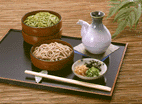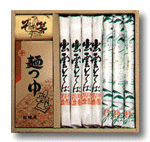 The
Japanese soba, a buckwheat noodle, is usually divided into "Shinshu
soba," popular in the eastern part of the country and "Izumo soba,"
popular in the western part. The
Japanese soba, a buckwheat noodle, is usually divided into "Shinshu
soba," popular in the eastern part of the country and "Izumo soba,"
popular in the western part.
The characteristics of Izumo soba are
first noticeable in its color. Unlike Shinshu soba, made of husked soba
nuts, Izumo soba is made of unhusked nuts, which makes it brown. (With a
comparable taste, Izumo soba has the merit of incorporating the eventual
nutrients included in the husks.)
Another difference resides in the serving
style. Izumo soba is served in stacked bowls called warigo.
Condiments like sliced onion are first put directly on the soba in the
bowls and the soba soup, tsuyu, is then poured over it. Usually a
person is served three bowls.
The Izumo people have a culture of
combining soba and tea. For instance, Matsudaira Fumai, the famous tea
master, was also a great soba lover (as can be seen from the lines
above).
In making our tea-soba, we
therefore aim to put this combined tradition into reality; and we
endeavor to do it in the best possible way.
 Cha Soba
Cha Soba
This product is made from Izumo soba to which we add enough of the
matcha (powdered green tea) we produce in our factory.
 |
Cha Soba
(A-34)
130g 200 yen
This is a result of special
investigations we made so that the matcha does not loose its aroma
during the production process.
|
 Sencha Soba
Sencha Soba
In making Sencha Soba, we select well-prepared soba flour to which we
add sencha blended in our
factory.
 |
Sencha
Soba
(A-38)
130g 220 yen
Sencha soba has a taste slightly
different from Cha Soba. Do try it, you will love it.
|
 Cha Somen Like Cha-Soba, our Cha
Somen (thin noodles) is made by combining powdered tea and soba flour.
Cha Somen Like Cha-Soba, our Cha
Somen (thin noodles) is made by combining powdered tea and soba flour.
 |
Cha Somen
(A-22)
225g 450 yen
This green somen is made with
dexterity so as to slide gently down the throat, refreshing
during the hot summer days.
|
Besides the above
samples,
we have prepared Gift Sets.

Most of the sets are assorted with
pure teas in the same package.
|